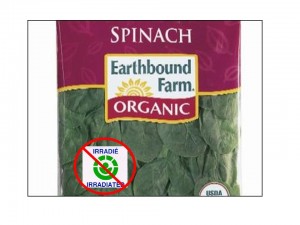Rick Holley, a professor in the department of food science at the University of Manitoba writes in the Winnipeg Free Press that Canadians who were alarmed by the recent outbreak of E. coli sickness from beef should know that pathogen contamination in processing plants cannot be prevented. If we really want to prevent outbreaks, we have to look at expanded use of irradiation.
Available data show little progress in resolving challenges associated with contaminated food either here or in the U.S. There is concern — because there is no  strategy to implement interventions or ability to evaluate their effectiveness — that safe food in Canada is more by accident than by design.
strategy to implement interventions or ability to evaluate their effectiveness — that safe food in Canada is more by accident than by design.
The provinces and territories are finally establishing performance objectives limiting frequencies of poultry carcass contamination by Salmonella and Campylobacter. Unfortunately, compliance with these standards cannot be measured against changes in rates of human illness from poultry consumption because a yardstick does not exist. It is these kinds of well-intentioned but unco-ordinated programs that drain resources, spawn complacency and ultimately obstruct our ability to understand the root causes of the problems and fix them.
Food irradiation is the most intensively studied of all technologies used to process food. In spite of what its detractors may contend, evidence from over 100 years of study show it can effectively reduce pathogen contamination of foods at levels that do not create toxicity, affect its wholesomeness or nutritional adequacy.
Canadian approvals have been in place since the 1960s for treatment of potatoes, onions, wheat flour, spices and dry seasonings. Specific approvals for food irradiation exist in over 55 countries, including the EU.
In the U.S., irradiation of mangoes and a variety of produce, shrimp, poultry and red meat at specified doses is permitted and about seven to eight million kilograms of irradiated ground beef is consumed annually.
Irradiation of produce at low dose in international trade is gaining acceptance, largely because it replaces pesticide use for quarantine control of insects.
Obstacles to irradiation adoption include its availability, costs of the technology, and concern about public perception.
Irradiation will not hide incompetence in industry practice and electron beams do not generate radioactive waste. Slow adoption of food irradiation is mainly due to psychological and political barriers.
If poultry alone were irradiated to eliminate Campylobacter (the major cause of food-borne illness) and Salmonella, data show that food-borne illness in Canada would be reduced immediately by 25 per cent.
Concerns regarding expanded use of food irradiation require transparent consideration. However, it is clear that there is no need to reinvent studies to show its generic safety and efficacy.
Indeed, organic farmers should reconsider their opposition given the equal risk that an organic product might be involved in the next Salmonella recall. There is no room for complacency either; it is time to use food irradiation for our collective good.
